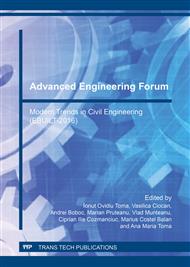[1]
T. Nishino, K. Hirao, M. Kotera, K. Nakamae, et H. Inagaki, « Kenaf reinforced biodegradable composite », Compos. Sci. Technol., vol. 63, no 9, p.1281‑1286, juill. (2003).
DOI: 10.1016/s0266-3538(03)00099-x
Google Scholar
[2]
S. Sampaio, D. Bishop, et J. Shen, « Physical and chemical properties of flax fibres from stand-retted crops desiccated at different stages of maturity », Ind. Crops Prod., vol. 21, no 3, p.275‑284, mai (2005).
DOI: 10.1016/j.indcrop.2004.04.001
Google Scholar
[3]
Y. Millogo, J. -C. Morel, J. -E. Aubert, et K. Ghavami, « Experimental analysis of Pressed Adobe Blocks reinforced with Hibiscus cannabinus fibers », Constr. Build. Mater., vol. 52, p.71‑78, févr. (2014).
DOI: 10.1016/j.conbuildmat.2013.10.094
Google Scholar
[4]
G. H. D. Tonoli, S. F. Santos, H. Savastano, S. Delvasto, R. Mejía de Gutiérrez, et M. del M. Lopez de Murphy, « Effects of natural weathering on microstructure and mineral composition of cementitious roofing tiles reinforced with fique fibre », Cem. Concr. Compos., vol. 33, no 2, p.225‑232, févr. (2011).
DOI: 10.1016/j.cemconcomp.2010.10.013
Google Scholar
[5]
M. Ramli, W. H. Kwan, et N. F. Abas, « Strength and durability of coconut-fiber-reinforced concrete in aggressive environments », Constr. Build. Mater., vol. 38, p.554‑566, janv. (2013).
DOI: 10.1016/j.conbuildmat.2012.09.002
Google Scholar
[6]
M. Ali et N. Chouw, « Experimental investigations on coconut-fibre rope tensile strength and pullout from coconut fibre reinforced concrete », Constr. Build. Mater., vol. 41, p.681‑690, avr. (2013).
DOI: 10.1016/j.conbuildmat.2012.12.052
Google Scholar
[7]
T. Ashour, H. Wieland, H. Georg, F. -J. Bockisch, et W. Wu, « The influence of natural reinforcement fibres on insulation values of earth plaster for straw bale buildings », Mater. Des., vol. 31, no 10, p.4676‑4685, déc. (2010).
DOI: 10.1016/j.matdes.2010.05.026
Google Scholar
[8]
H. -R. Kymäläinen et A. -M. Sjöberg, « Flax and hemp fibres as raw materials for thermal insulations », Build. Environ., vol. 43, no 7, p.1261‑1269, juill. (2008).
DOI: 10.1016/j.buildenv.2007.03.006
Google Scholar
[9]
A. GRELAT, « Utilisation de la paille en parois de maisons individuelles à ossature bois », Extr. Rapp. Final, vol. 2, (2004).
Google Scholar
[10]
M. Bouasker, N. Belayachi, D. Hoxha, et M. Al-Mukhtar, « Physical Characterization of Natural Straw Fibers as Aggregates for Construction Materials Applications », Materials, vol. 7, no 4, p.3034‑3048, avr. (2014).
DOI: 10.3390/ma7043034
Google Scholar
[11]
N. Belayachi, M. Bouasker, D. Hoxha, et M. Al-Mukhtar, « Thermo-Mechanical Behaviour of an Innovant Straw Lime Composite for Thermal Insulation Applications », Appl. Mech. Mater., vol. 390, p.542‑546, (2013).
DOI: 10.4028/www.scientific.net/amm.390.542
Google Scholar
[12]
N. Belayachi, D. Hoxha, et M. Slaimia, « Durability studies on lightweight plaster and straw fiber based material for building thermal insulation », ICBBM 2015, p.203‑207, (2015).
DOI: 10.1016/j.conbuildmat.2016.08.120
Google Scholar
[13]
H. M. Künzel, Simultaneous heat and moisture transport in building components: one- and two-dimensional calculation using simple parameters. Stuttgart: IRB Verlag, (1995).
Google Scholar
[14]
J. M. P. Q. Delgado, N. M. M. Ramos, E. Barreira, et V. P. de Freitas, « A CRITICAL REVIEW OF HYGROTHERMAL MODELS USED IN POROUS BUILDING MATERIALS », J. Porous Media, vol. 13, no 3, p.221‑234, (2010).
DOI: 10.1615/jpormedia.v13.i3.30
Google Scholar
[15]
T. Kalamees et J. Vinha, « Hygrothermal calculations and laboratory tests on timber-framed wall structures », Build. Environ., vol. 38, no 5, p.689‑697, mai (2003).
DOI: 10.1016/s0360-1323(02)00207-x
Google Scholar
[16]
H. Rafidiarison, R. Rémond, A. Nicolas, et E. Mougel, « Etudes expérimentale et numérique du comportement hygrothermique des matériaux hygroscopiques », (2013).
Google Scholar
[17]
H. M. KÜNZEL et K. KIESSL, « Calculation of heat and moisture transfer in exposed building components », Int. J. Heat Mass Transf., vol. 40, no 1, p.159‑167, oct. (1996).
DOI: 10.1016/s0017-9310(96)00084-1
Google Scholar
[18]
H. M. Künzel, A. Holm, D. Zirkelbach, et A. N. Karagiozis, « Simulation of indoor temperature and humidity conditions including hygrothermal interactions with the building envelope », Sol. Energy, vol. 78, no 4, p.554‑561, avr. (2005).
DOI: 10.1016/j.solener.2004.03.002
Google Scholar
[19]
H. Künzel, T. Schmidt, et A. Holm, « Exterior surface temperature of different wall constructions comparison of numerical simulation and experiment », in Proceedings of the 11th Symposium for Building Physics, Dresden, Germany, 2002, vol. 1, p.441.
Google Scholar
[20]
M. Künzel, « Factors determining surface moisture on external walls », in Proceedings of the XI International Conference Thermal Performance of the Exterior Envelopes of Whole Buildings, 2010, p.1–6.
Google Scholar
[21]
B. Stöckl et D. Zirkelbach, « Hygrothermal simulation of green roofs–new models and practical application », in Nordic Symp. Building Physics, Lund, 2014, p.15–19.
Google Scholar
[22]
F. Antretter, F. Sauer, T. Schöpfer, et A. Holm, « Validation of a hygrothermal whole building simulation software », in Proceedings of Building Simulation 2011: 12th Conference of International Building Performance Simulation Association, Sydney, Australia, 2011, vol. 14, p.16.
Google Scholar
[23]
O. Hägerstedt et J. Arfvidsson, « Comparison of field measurements and calculations of relative humidity and temperature in wood framed walls », in Thermophysics 2010, 2010, p.93–101.
Google Scholar


